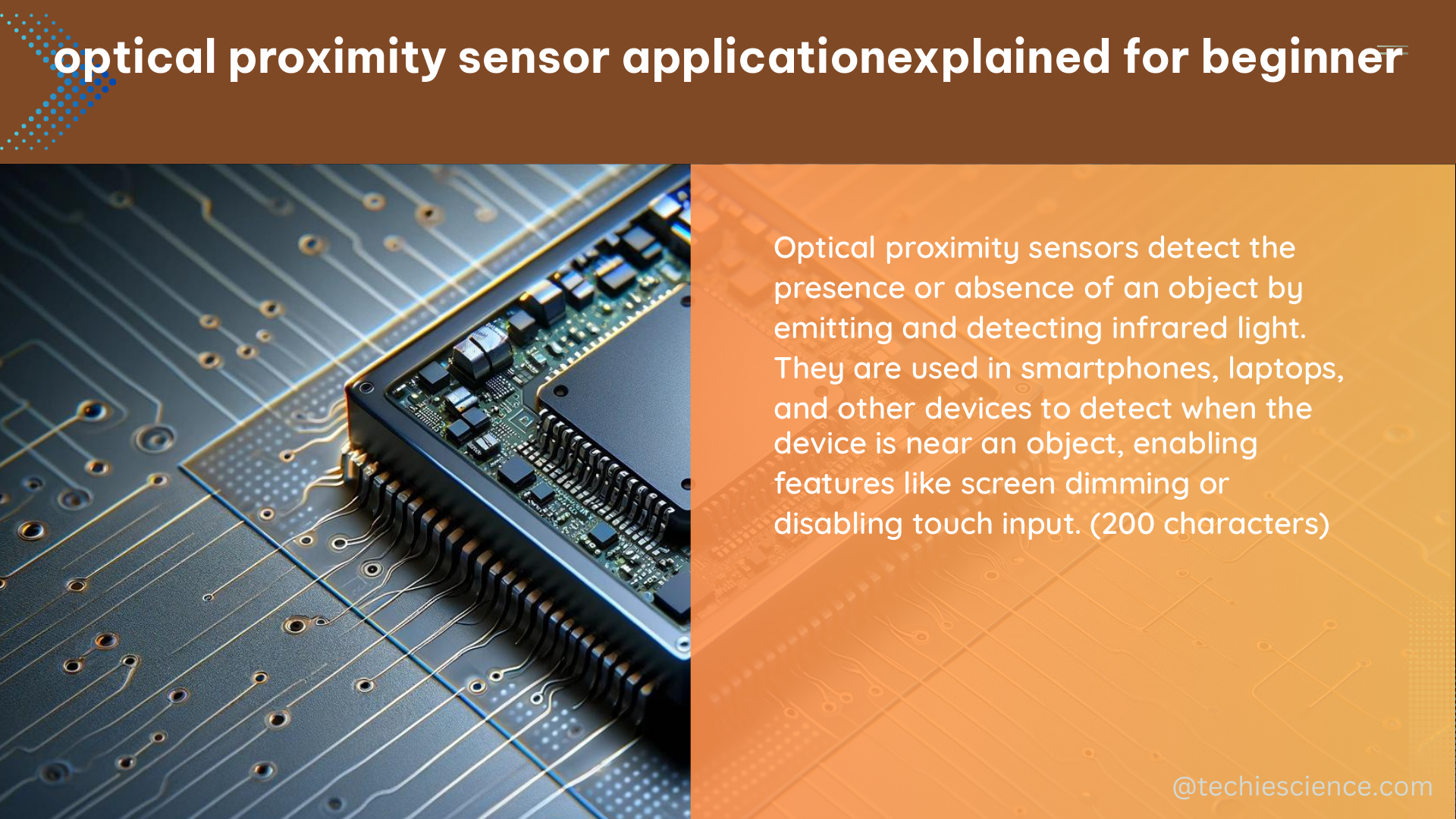Optical proximity sensors are a versatile and widely used type of sensor that employ light to detect the presence or absence of objects within their sensing range. These sensors find numerous applications in industrial automation, robotics, and various other domains, making them an essential component in modern technological advancements. In this comprehensive guide, we will delve into the intricacies of optical proximity sensors, their working principles, types, and practical applications, equipping you with the knowledge to understand and utilize these powerful devices effectively.
Understanding Optical Proximity Sensors
Optical proximity sensors operate by emitting a beam of light, typically in the infrared or visible spectrum, and detecting the reflection or interruption of that beam. When an object enters the sensor’s detection zone, the light beam is either reflected back to the sensor (in the case of reflective sensors) or interrupted (in the case of through-beam sensors), triggering a response from the sensor.
These sensors offer several advantages over other types of proximity sensors, such as:
- Wide Detection Range: Optical proximity sensors can detect objects at distances ranging from a few centimeters to several meters, making them suitable for a wide variety of applications.
- High Switching Frequency: With switching frequencies of up to several kilohertz, optical proximity sensors can be used in high-speed applications, such as in packaging and assembly lines.
- Versatility: Optical proximity sensors can detect a wide range of materials, including transparent and translucent objects, as well as objects with varying surface characteristics.
Types of Optical Proximity Sensors

There are three main types of optical proximity sensors, each with its own unique characteristics and applications:
- Through-Beam Sensors:
- These sensors consist of a separate transmitter and receiver unit.
- The transmitter emits a beam of light, and the receiver detects the presence of an object by monitoring the interruption of the light beam.
- Through-beam sensors are often used for object detection, positioning, and counting applications.
-
They offer a longer sensing range compared to other types of optical proximity sensors.
-
Retro-Reflective Sensors:
- Retro-reflective sensors use a reflector to bounce the light beam back to the sensor.
- When an object enters the sensing area, it interrupts the reflected light beam, triggering the sensor.
- These sensors are compact and can be easily integrated into various systems.
-
They are commonly used for applications such as part detection, positioning, and level measurement.
-
Diffuse-Reflective Sensors:
- Diffuse-reflective sensors rely on the reflection of light off the target object itself.
- The sensor emits a beam of light, and the reflected light is detected by the sensor’s receiver.
- These sensors are suitable for detecting objects with varying surface characteristics, including matte, glossy, or irregular surfaces.
- Diffuse-reflective sensors are often used for applications where the object’s position or orientation is not critical, such as presence/absence detection.
Technical Specifications and Considerations
When selecting an optical proximity sensor for your application, it’s essential to consider the following technical specifications and factors:
- Detection Range: Optical proximity sensors can have a detection range from a few centimeters up to several meters, depending on the sensor type and design.
- Sensing Beam: Optical proximity sensors typically use infrared or visible light, with wavelengths ranging from 850 nm to 950 nm for infrared and 400 nm to 700 nm for visible light.
- Switching Frequency: The switching frequency of optical proximity sensors can range from a few hertz to several kilohertz, allowing them to be used in high-speed applications.
- Sensing Beam Diameter: The diameter of the sensing beam can vary, with smaller beam diameters allowing for more precise object detection.
- Ambient Light Immunity: Optical proximity sensors should be able to operate reliably in the presence of ambient light, such as sunlight or artificial lighting, to avoid false triggers.
- Environmental Factors: Factors like dirt, dust, humidity, and temperature can affect the performance of optical proximity sensors, so it’s essential to select sensors that can withstand the specific environmental conditions of the application.
Applications of Optical Proximity Sensors
Optical proximity sensors find a wide range of applications across various industries, including:
- Industrial Automation:
- Object detection and positioning
- Level measurement
- Counting and sorting
-
Packaging and assembly line control
-
Robotics and Automation:
- Collision avoidance
- Robotic arm positioning
-
Conveyor belt monitoring
-
Automotive:
- Headlight and taillight activation
- Windshield wiper control
-
Occupancy detection
-
Consumer Electronics:
- Smartphone screen activation/deactivation
- Gesture recognition
-
Proximity-based power management
-
Building Automation:
- Automatic door and gate control
- Lighting control
-
Security and access control
-
Medical and Healthcare:
- Patient monitoring
- Surgical instrument tracking
- Prosthetic limb control
By understanding the capabilities and applications of optical proximity sensors, you can effectively integrate these versatile devices into your projects and harness their power to enhance automation, improve efficiency, and enable innovative solutions across a wide range of industries.
Reference:
- The Beginner’s Guide to Automation: Making Sense of Prox Sensors (https://control.com/technical-articles/the-beginners-guide-to-automation-making-sense-of-prox-sensors/)
- A Complete Guide to Proximity Sensors (https://uk.rs-online.com/web/content/discovery/ideas-and-advice/proximity-sensors-guide)
- TheraProx: Capacitive Proximity Sensing (https://www.researchgate.net/publication/358202952_TheraProx_Capacitive_Proximity_Sensing)

The lambdageeks.com Core SME Team is a group of experienced subject matter experts from diverse scientific and technical fields including Physics, Chemistry, Technology,Electronics & Electrical Engineering, Automotive, Mechanical Engineering. Our team collaborates to create high-quality, well-researched articles on a wide range of science and technology topics for the lambdageeks.com website.
All Our Senior SME are having more than 7 Years of experience in the respective fields . They are either Working Industry Professionals or assocaited With different Universities. Refer Our Authors Page to get to know About our Core SMEs.